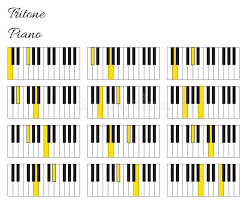How to use tritones in music Lesson 4
If you read through that first part, you would know what a Tritone is and what a tritone voicing is.
You would also know the 6 unique tritone pairs and you would also know some of the types of progression that was mentioned.
Voicing a chord with the tritone voicing takes us getting used to which chords can be voiced as such. ANY tritonic chord [i.e. one having a tritone interval within its notes] can be voiced to have the tritone pair as the lowest notes of the voicing. Dominant chords are easy targets for this because their shells are already a tritone pair. The shell of any dominant structured chord is the major third [M3 a.k.a 3] and the minor 7th [m7 a.k.a b7] intervals. The 3+b7 pair is ALWAYS a tritone pair for dominant structured chords. There are other chords that are also tritonic - minor 6 chords [e.g. Dmin6 as DFAB], min7b5 chords [e.g. Amin7b5 as ACEbG], dim7 chords [e.g. Bdim7 as BDFAb] , augmented 11th chords and diminished 5th chord [e.g. Cmaj13#11 as CEGBDF#A and Abma7b5 as AbCDG], etc. A look at these examples shows the pairs in them.
Basically, these tritone pairs are [mostly] played on the Left Hand [LH] and the other notes are played on the Right Hand [RH]. An example is B9b13 as C#G/BD#F#A and C9 as EBb/DGC. Know the 6 pairs and the LH is covered.

-ChordProgressionGuy
#pianolessons #chords #scales #piano #chordprogression #inversions #tutorial #music #tritones #jazz #lesson #mouvement